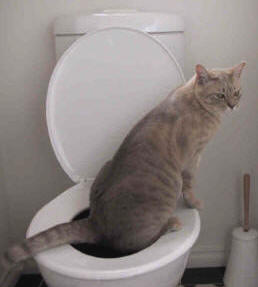Prevent Plumbing Problems: Don't Flush Cat Poop Down Your Toilet - Professional Advice
Prevent Plumbing Problems: Don't Flush Cat Poop Down Your Toilet - Professional Advice
Blog Article
Just about everyone has got their personal theory on the subject of How to Dispose of Cat Poop and Litter Without Plastic Bags.

Intro
As feline proprietors, it's important to be mindful of how we throw away our feline buddies' waste. While it might seem hassle-free to flush feline poop down the toilet, this method can have detrimental repercussions for both the environment and human wellness.
Environmental Impact
Purging cat poop introduces unsafe microorganisms and bloodsuckers into the supply of water, posturing a considerable threat to water ecological communities. These contaminants can adversely influence marine life and compromise water top quality.
Health Risks
In addition to ecological problems, flushing feline waste can additionally pose health and wellness threats to humans. Cat feces may consist of Toxoplasma gondii, a bloodsucker that can cause toxoplasmosis-- a potentially serious ailment, particularly for pregnant ladies and people with damaged body immune systems.
Alternatives to Flushing
Fortunately, there are safer and much more accountable methods to take care of cat poop. Think about the complying with options:
1. Scoop and Dispose in Trash
One of the most usual approach of disposing of cat poop is to scoop it into a biodegradable bag and throw it in the trash. Be sure to use a specialized clutter scoop and get rid of the waste immediately.
2. Use Biodegradable Litter
Go with eco-friendly cat trash made from materials such as corn or wheat. These trashes are eco-friendly and can be safely disposed of in the garbage.
3. Hide in the Yard
If you have a yard, consider hiding pet cat waste in a marked location far from veggie yards and water sources. Be sure to dig deep sufficient to stop contamination of groundwater.
4. Mount a Pet Waste Disposal System
Invest in a pet garbage disposal system particularly created for feline waste. These systems use enzymes to break down the waste, reducing smell and ecological effect.
Final thought
Responsible pet dog possession prolongs past supplying food and shelter-- it also entails appropriate waste administration. By refraining from purging pet cat poop down the bathroom and choosing alternative disposal approaches, we can minimize our ecological impact and safeguard human health.
Why Can’t I Flush Cat Poop?
It Spreads a Parasite
Cats are frequently infected with a parasite called toxoplasma gondii. The parasite causes an infection called toxoplasmosis. It is usually harmless to cats. The parasite only uses cat poop as a host for its eggs. Otherwise, the cat’s immune system usually keeps the infection at low enough levels to maintain its own health. But it does not stop the develop of eggs. These eggs are tiny and surprisingly tough. They may survive for a year before they begin to grow. But that’s the problem.
Our wastewater system is not designed to deal with toxoplasmosis eggs. Instead, most eggs will flush from your toilet into sewers and wastewater management plants. After the sewage is treated for many other harmful things in it, it is typically released into local rivers, lakes, or oceans. Here, the toxoplasmosis eggs can find new hosts, including starfish, crabs, otters, and many other wildlife. For many, this is a significant risk to their health. Toxoplasmosis can also end up infecting water sources that are important for agriculture, which means our deer, pigs, and sheep can get infected too.
Is There Risk to Humans?
There can be a risk to human life from flushing cat poop down the toilet. If you do so, the parasites from your cat’s poop can end up in shellfish, game animals, or livestock. If this meat is then served raw or undercooked, the people who eat it can get sick.
In fact, according to the CDC, 40 million people in the United States are infected with toxoplasma gondii. They get it from exposure to infected seafood, or from some kind of cat poop contamination, like drinking from a stream that is contaminated or touching anything that has come into contact with cat poop. That includes just cleaning a cat litter box.
Most people who get infected with these parasites will not develop any symptoms. However, for pregnant women or for those with compromised immune systems, the parasite can cause severe health problems.
How to Handle Cat Poop
The best way to handle cat poop is actually to clean the box more often. The eggs that the parasite sheds will not become active until one to five days after the cat poops. That means that if you clean daily, you’re much less likely to come into direct contact with infectious eggs.
That said, always dispose of cat poop in the garbage and not down the toilet. Wash your hands before and after you clean the litter box, and bring the bag of poop right outside to your garbage bins.
https://trenchlesssolutionsusa.com/why-cant-i-flush-cat-poop/

We hope you enjoyed our part about Can You Flush Cat Poo or Litter Down the Toilet?. Thanks for finding the time to read through our piece. Are you aware of another person who is serious about the topic? Take a moment to promote it. We take joy in reading our article about Can You Flush Cat Poo or Litter Down the Toilet?.
Visit Our Website Report this page